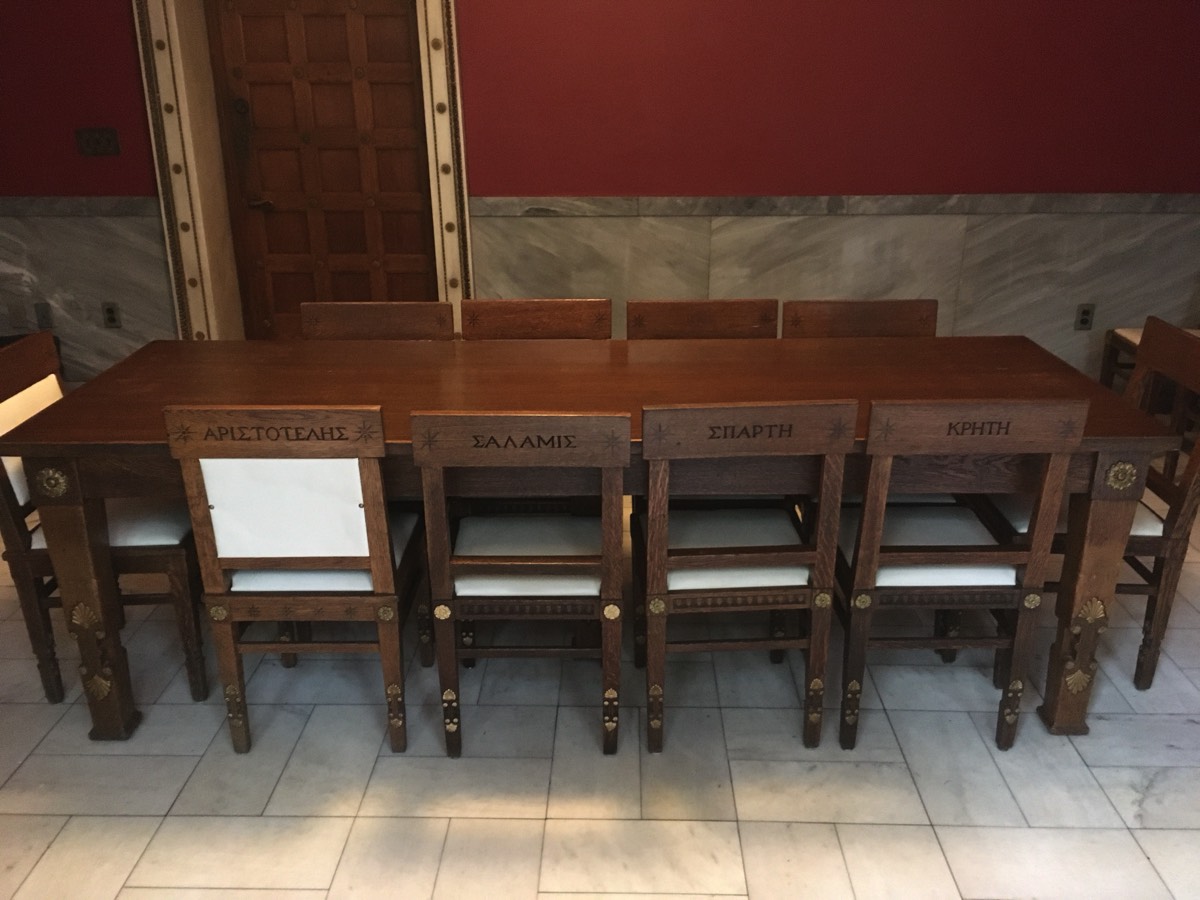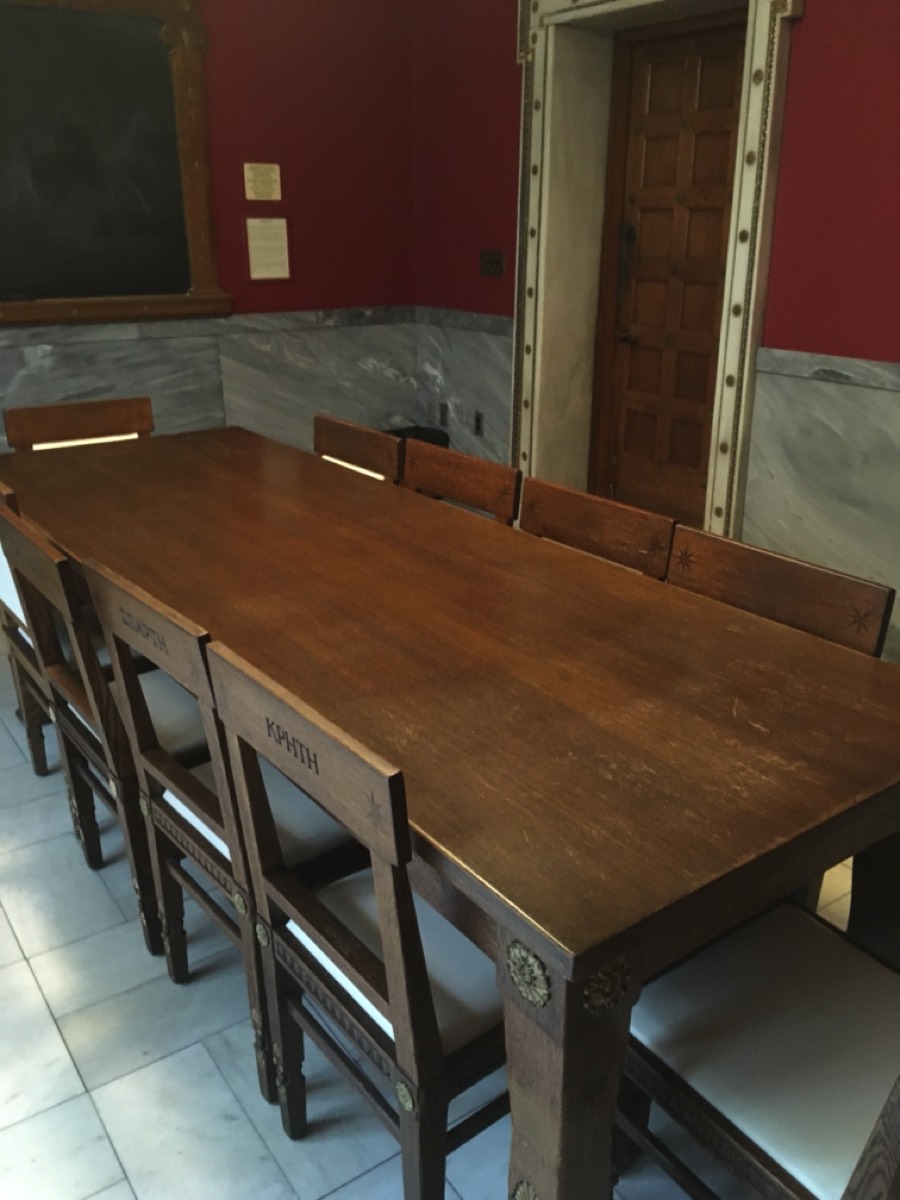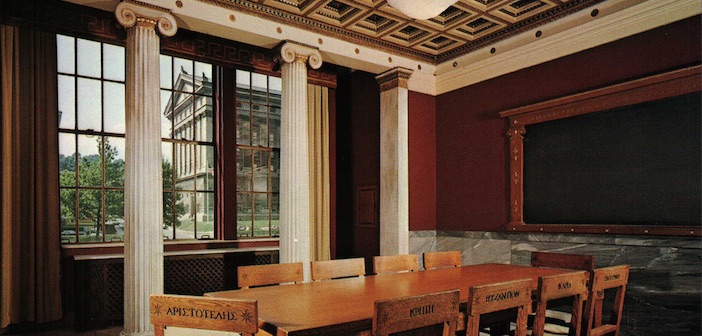
About the Greek Nationality Room
Mission Statement (click arrow to open)
Our Mission: To foster knowledge and appreciation of the history and culture of Greece, from ancient to modern times, among students, faculty, staff, and visitors. To sensitize about Greece's ciritcal role in the shaping of democracy, democratic ideals and the rule of law. To highlight the historical contributions of Greece to human civilization in the sciences, literature, and the arts. To remind that the central Hellenic virtues of philotimo (respect and honor of others) and philoxenia (friend of the stranger) are at the basis of Greece's intercultural thinking and evolution, and shape the way Greeks in Greece and in the Diaspora think of, and work with sister communities.
The Committee elected to serve and nurture the Mission conceptualizes and realizes events related to the history and culture of Greece, always aiming to educate and raise awareness among students, faculty, staff, and visitors. It works with a number of regional partners and entities in Greece in this regard.
The Committee also participates in the administration of the Scholarship, granted to meritorious students enrolled at the University of Pittsburgh, for a summer study period in Greece or Cyprus.

The Nationality Room Program at the University of Pittsburgh was founded in 1926 with the objective of involving the founding communities of Western Pennsylvania to provide the spiritual and symbolic foundation of the Cathedral of Learning building that what would make the inside of the building as inspiring and impressive as the outside.
Beginning in 1926, invitations were extended to representatives of the communities that made up the Pittsburgh area to provide a room that was representative of their heritage. Each group had to form a Room Committee, which would be responsible for all fundraising, designing, and acquisition. The University provided the room and upkeep in perpetuity once completed, while all other materials, labor, and design were provided by the individual committees.
In addition, some of the aspects of the Rooms were a consequence of generous donations by the governments of the nations represented by the specific Room which, "...responded with generous support, often providing architects, artists, materials, and monetary gifts to assure authenticity and superb quality in the Rooms".
Each room's detail was carefully designed and executed down to the switch plates, door handles, hinges, and wastebaskets. The work was often performed and designed by native artists and craftsmen and involved imported artifacts and materials. Upon completion of a room, a dedication ceremony was held in which a formal presentation of a ceremonial key is presented to the University's Chancellor in order to symbolize the bestowal and acceptance of the gift with a commitment on behalf of the University to maintain the room in perpetuity. The particular nationality room committee's officers then become active members of the Nationality Council which focuses on providing summer study abroad scholarships for Pitt students along with other non-political cultural or educational events within the Nationality Program's scope. Such is the case for the Greek Nationality Room.

The classical architecture of the Greek Room represents 5th-century classical Greek architecture and the Golden Age of Pericles. It includes marble columns and a coffered ceiling painted with the Star of Vergina, the historical royal symbol of ancient Macedonia, the Greek Argead dynasty from which arose Alexander the Great.
Colored details from the Acropolis' Propylaea and Erectheum appear on white marble. The floor is paved with rectangular slabs quarried from Mount Penteli, the same source of the marbles that were used to construct the Parthenon on the Acropolis more than 24 centuries ago.
Gray Kokinara marble is used for the dado. The room's columns and pilasters, as well as the coffered ceiling, bear painted decorations identical to those used on ancient Greek structures. The deep red wall color is repeated in the drapery valance with its Greek key design.
The Room’s artwork was done by Athenian artist Demetrios Kokotsis and his nephew, Raymond Kokotzis, who laboriously painted all of the ornamental motifs by hand using the traditional encaustic painting method, employing earth colors and beeswax applied freehand which was then overlaid with 24-carat gold leaf rubbed on by polishing bones. No small feat, this required the two men more than seven months to complete.
The white oak furniture, patterned after designs on Greek vases, is decorated with gold-leaf carvings and sunburst inlays of ebony. Student chair backs carry the names, in Greek, of the islands and towns from which the earliest Greek immigrants to Western Pennsylvania came from who were also major donors to realize the Greek Room. Specifically, Asia Minor represented as Byzantium and Smyrna, the regions of Epirus and Macedonia, the great region of Athens and its close historical island of Salamis, the great city state of Sparta, the Aegean islands of Chios, Lesbos, Carpathos, Samos and Icaria, the Mediterranean island of Crete, and the small town of Vlahokerasia in the Peloponnese.
The professor's and guests' chairs bear the names of Plato, Aristotle, and Socrates.
A line from Homer's Iliad, on the blackboard, exhorts students to strive for nobility and excellence.